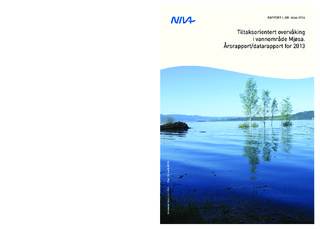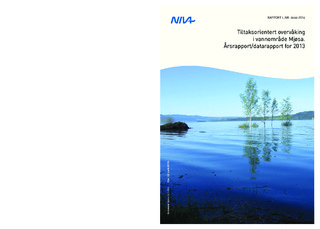| dc.contributor.author | Løvik, Jarl Eivind | |
| dc.contributor.author | Brettum, Pål | |
| dc.contributor.author | Kile, Maia Røst | |
| dc.contributor.author | Skjelbred, Birger | |
| dc.date.accessioned | 2014-05-12T11:32:32Z | |
| dc.date.accessioned | 2014-05-26T13:36:48Z | |
| dc.date.available | 2014-05-12T11:32:32Z | |
| dc.date.available | 2014-05-26T13:36:48Z | |
| dc.date.issued | 2014 | |
| dc.identifier.citation | Løvik, J. E.; Brettum, P.; Kile, M.R. et al. 2014 Tiltaksorientert overvåking i vannområde Mjøsa. Årsrapport/datarapport for 2013 (NIVA-rapport; 6666) 84 p. | nb_NO |
| dc.identifier.isbn | 978-82-577-6401-2 | |
| dc.identifier.issn | 0803-625X | |
| dc.identifier.uri | http://hdl.handle.net/11250/195493 | |
| dc.description.abstract | Rapporten omhandler vannkvalitet og biologiske forhold i vannområde Mjøsa i 2013 samt tidsutviklingen gjennom
overvåkingsperioden 1972-2013. Miljøtilstanden i Mjøsa og i tilløpselvene har blitt sterkt forbedret med hensyn til overgjødsling
siden 1970- og 1980-tallet. Algemengden målt som klorofyll-a og total planteplanktonbiomasse er henholdsvis 50 % og 60 % lavere
enn på 1970-tallet. I 2013 var imidlertid algemengden relativt høy, med midlere og maks planteplanktonbiomasse på henholdsvis 0,5-
0,7 g/m³ og 1,4-2,1 g/m³ ved de ulike prøvestasjonene. Dette er den høyeste algemengden siden 2002, og det er klart høyere (dvs.
dårligere) enn miljømålet for Mjøsa. Det var særlig en markert topp med kiselalger i august-september som dro opp middelverdiene.
Algemengden og algesammensetningen tilsier god økologisk tilstand ved stasjon Brøttum, men moderat tilstand ved de tre øvrige
stasjonene i 2013. Konsentrasjonen av total-fosfor (tot-P) i Mjøsa har blitt betydelig redusert etter Mjøsaksjonene på 1970- og 1980-
tallet, men konsentrasjonen har økt litt de senere årene. Økningen skyldes trolig store tilførsler fra nedbørfeltet i tilknytning til
perioder med stor avrenning i disse årene, spesielt under flommene i 2011 og 2013. Medianverdier for konsentrasjonen av tot-P i
elver i 2011-2013 tilsier svært god eller god tilstand i de 6 tilløpselvene som det gjøres målinger i. Konsentrasjonene av tot-P har økt
noe i de senere årene i flere av elvene slik som Gausa, Flagstadelva og Svartelva. Basert på undersøkelser av begroingsalger og
bunndyr i nedre deler av Gudbrandsdalslågen og Svartelva ble økologisk tilstand vurdert som god på disse lokalitetene i 2013 | |
| dc.description.abstract | The report presents data from the monitoring project on Lake Mjøsa, its tributaries and the outlet river
Vorma, emphasizing results from 2013 and long-term trends in water quality and environmental status for
the period 1972-2013.
As a result of comprehensive pollution abatement measures, the water quality of Lake Mjøsa has
improved markedly since the 1970ies and the 1980ies. The amount of algae, expressed as mean
chlorophyll-a and mean phytoplankton biomass, has been reduced by 50 % and 60 % respectively since
the 1970ies. However, in 2013, the phytoplankton biomass was rather high during a diatom “bloom” in
late August and early September, indicating mesotrophic conditions. At that time diatoms comprised
approximately 90 % of the phytoplankton biomass, with Tabellaria fenestrata as dominant species and
Fragilaria crotonensis and Asterionella formosa as subdominant species.
Based on mean algal biomass and composition of the phytoplankton in 2013, the ecological status was
classified as moderate at all sampling stations except for station Brøttum, situated in the northern part of
the lake. This means that environmental condition of Lake Mjøsa concerning eutrophication was not
acceptable in 2013. Using data from the 3-year period 2011-2013 improved the results to good ecological
status for all four sampling stations, but close to moderate status for the sampling station Furnesfjorden.
Tot-P mean value for the algal growth season declined from 8-12 μg P/l in the 1970ies to 4-5 μg P/l in
years 2002-2008. In years 2009-2013 the tot-P mean values varied in the range 5-8 μg P/l. This increase
was probably caused by relative large P-inputs from the catchment during periods with high run off in
later years, especially during the late spring floods in 2011 and 2013.
Median values for tot-P concentrations in the six main inlet rivers indicated high or good ecological status
for the 3-year period 2011-2013. However, in several rivers like Gausa, Flagstadelva and Svartelva volume
weighted mean values for tot-P seem to have increased during later years. Based on investigations of the
communities of benthic algae and benthic invertebrates the ecological status was classified as good at the
sampling stations situated in the lower parts of the rivers Gudbrandsdalslågen and Svartelva in 2013. | |
| dc.language.iso | nob | nb_NO |
| dc.publisher | Norsk institutt for vannforskning | nb_NO |
| dc.relation.ispartofseries | NIVA-rapport;6666 | |
| dc.rights | Attribution-NonCommercial-ShareAlike 3.0 Norway | * |
| dc.rights.uri | http://creativecommons.org/licenses/by-nc-sa/3.0/no/ | * |
| dc.title | Tiltaksorientert overvåking i vannområde Mjøsa. Årsrapport/datarapport for 2013 | nb_NO |
| dc.title.alternative | Monitoring of Lake Mjøsa, S Norway. Annual report for 2013 | |
| dc.type | Research report | nb_NO |
| dc.date.updated | 2014-05-12T11:32:33Z | |
| dc.subject.nsi | VDP::Matematikk og naturvitenskap: 400 | |
| dc.subject.nsi | VDP::Mathematics and natural scienses: 400 | |
| dc.identifier.cristin | 1132332 | |
| dc.subject.keyword | Eutrofiering / Eutrophication | |
| dc.subject.keyword | Miljøovervåkning / Environmental monitoring | |
| dc.subject.keyword | Mjøsa / Lake Mjøsa | |
| dc.subject.keyword | Vannressursforvaltning / Water Resources Management | |
| dc.relation.project | 84 | nb_NO |


